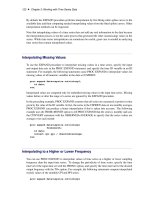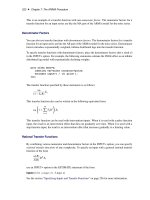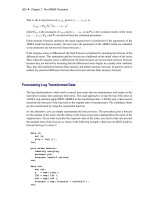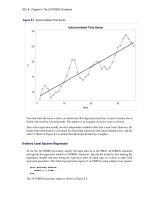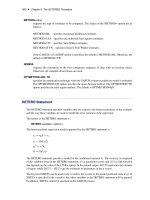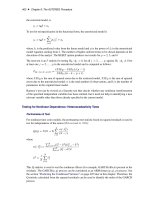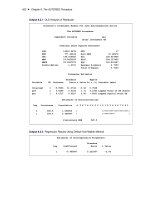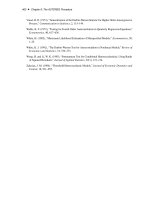SAS/ETS 9.22 User''''s Guide 24 pot
Bạn đang xem bản rút gọn của tài liệu. Xem và tải ngay bản đầy đủ của tài liệu tại đây (254.27 KB, 10 trang )
222 ✦ Chapter 7: The ARIMA Procedure
This is an example of a transfer function with one numerator factor. The numerator factors for a
transfer function for an input series are like the MA part of the ARMA model for the noise series.
Denominator Factors
You can also use transfer functions with denominator factors. The denominator factors for a transfer
function for an input series are like the AR part of the ARMA model for the noise series. Denominator
factors introduce exponentially weighted, infinite distributed lags into the transfer function.
To specify transfer functions with denominator factors, place the denominator factors after a slash (/)
in the INPUT= option. For example, the following statements estimate the PRICE effect as an infinite
distributed lag model with exponentially declining weights:
proc arima data=a;
identify var=sales crosscorr=price;
estimate input=( / (1) price );
run;
The transfer function specified by these statements is as follows:
!
0
.1 ı
1
B/
X
t
This transfer function also can be written in the following equivalent form:
!
0
1 C
1
X
iD1
ı
i
1
B
i
!
X
t
This transfer function can be used with intervention inputs. When it is used with a pulse function
input, the result is an intervention effect that dies out gradually over time. When it is used with a
step function input, the result is an intervention effect that increases gradually to a limiting value.
Rational Transfer Functions
By combining various numerator and denominator factors in the INPUT= option, you can specify
rational transfer functions of any complexity. To specify an input with a general rational transfer
function of the form
!.B/
ı.B/
B
k
X
t
use an INPUT= option in the ESTIMATE statement of the form
input=( k $ ( !-lags ) / ( ı-lags) x)
See the section “Specifying Inputs and Transfer Functions” on page 256 for more information.
Forecasting with Input Variables ✦ 223
Identifying Transfer Function Models
The CROSSCORR= option of the IDENTIFY statement prints sample cross-correlation functions
that show the correlation between the response series and the input series at different lags. The
sample cross-correlation function can be used to help identify the form of the transfer function
appropriate for an input series. See textbooks on time series analysis for information about using
cross-correlation functions to identify transfer function models.
For the cross-correlation function to be meaningful, the input and response series must be filtered
with a prewhitening model for the input series. See the section “Prewhitening” on page 250 for more
information about this issue.
Forecasting with Input Variables
To forecast a response series by using an ARIMA model with inputs, you need values of the input
series for the forecast periods. You can supply values for the input variables for the forecast periods
in the DATA= data set, or you can have PROC ARIMA forecast the input variables.
If you do not have future values of the input variables in the input data set used by the FORECAST
statement, the input series must be forecast before the ARIMA procedure can forecast the response
series. If you fit an ARIMA model to each of the input series for which you need forecasts before
fitting the model for the response series, the FORECAST statement automatically uses the ARIMA
models for the input series to generate the needed forecasts of the inputs.
For example, suppose you want to forecast SALES for the next 12 months. In this example, the
change in SALES is predicted as a function of the change in PRICE, plus an ARMA(1,1) noise process.
To forecast SALES by using PRICE as an input, you also need to fit an ARIMA model for PRICE.
The following statements fit an AR(2) model to the change in PRICE before fitting and forecasting
the model for SALES. The FORECAST statement automatically forecasts PRICE using this AR(2)
model to get the future inputs needed to produce the forecast of SALES.
proc arima data=a;
identify var=price(1);
estimate p=2;
identify var=sales(1) crosscorr=price(1);
estimate p=1 q=1 input=price;
forecast lead=12 interval=month id=date out=results;
run;
Fitting a model to the input series is also important for identifying transfer functions. (See the section
“Prewhitening” on page 250 for more information.)
Input values from the DATA= data set and input values forecast by PROC ARIMA can be combined.
For example, a model for SALES might have three input series: PRICE, INCOME, and TAXRATE. For
the forecast, you assume that the tax rate will be unchanged. You have a forecast for INCOME from
224 ✦ Chapter 7: The ARIMA Procedure
another source but only for the first few periods of the SALES forecast you want to make. You have
no future values for PRICE, which needs to be forecast as in the preceding example.
In this situation, you include observations in the input data set for all forecast periods, with SALES
and PRICE set to a missing value, with TAXRATE set to its last actual value, and with INCOME set to
forecast values for the periods you have forecasts for and set to missing values for later periods. In
the PROC ARIMA step, you estimate ARIMA models for PRICE and INCOME before you estimate
the model for SALES, as shown in the following statements:
proc arima data=a;
identify var=price(1);
estimate p=2;
identify var=income(1);
estimate p=2;
identify var=sales(1) crosscorr=( price(1) income(1) taxrate );
estimate p=1 q=1 input=( price income taxrate );
forecast lead=12 interval=month id=date out=results;
run;
In forecasting SALES, the ARIMA procedure uses as inputs the value of PRICE forecast by its
ARIMA model, the value of TAXRATE found in the DATA= data set, and the value of INCOME found
in the DATA= data set, or, when the INCOME variable is missing, the value of INCOME forecast by
its ARIMA model. (Because SALES is missing for future time periods, the estimation of model
parameters is not affected by the forecast values for PRICE, INCOME, or TAXRATE.)
Data Requirements
PROC ARIMA can handle time series of moderate size; there should be at least 30 observations. With
fewer than 30 observations, the parameter estimates might be poor. With thousands of observations,
the method requires considerable computer time and memory.
Syntax: ARIMA Procedure
The ARIMA procedure uses the following statements:
PROC ARIMA options ;
BY variables ;
IDENTIFY VAR=variable options ;
ESTIMATE options ;
OUTLIER options ;
FORECAST options ;
The PROC ARIMA and IDENTIFY statements are required.
Functional Summary ✦ 225
Functional Summary
The statements and options that control the ARIMA procedure are summarized in Table 7.3.
Table 7.3 Functional Summary
Description Statement Option
Data Set Options
specify the input data set PROC ARIMA DATA=
IDENTIFY DATA=
specify the output data set PROC ARIMA OUT=
FORECAST OUT=
include only forecasts in the output data set FORECAST NOOUTALL
write autocovariances to output data set IDENTIFY OUTCOV=
write parameter estimates to an output data set
ESTIMATE OUTEST=
write correlation of parameter estimates ESTIMATE OUTCORR
write covariance of parameter estimates ESTIMATE OUTCOV
write estimated model to an output data set ESTIMATE OUTMODEL=
write statistics of fit to an output data set ESTIMATE OUTSTAT=
Options for Identifying the Series
difference time series and plot autocorrelations
IDENTIFY
specify response series and differencing IDENTIFY VAR=
specify and cross-correlate input series IDENTIFY CROSSCORR=
center data by subtracting the mean IDENTIFY CENTER
exclude missing values IDENTIFY NOMISS
delete previous models and start IDENTIFY CLEAR
specify the significance level for tests IDENTIFY ALPHA=
perform tentative ARMA order identification
by using the ESACF method
IDENTIFY ESACF
perform tentative ARMA order identification
by using the MINIC method
IDENTIFY MINIC
perform tentative ARMA order identification
by using the SCAN method
IDENTIFY SCAN
specify the range of autoregressive model
orders for estimating the error series for the
MINIC method
IDENTIFY PERROR=
determine the AR dimension of the SCAN,
ESACF, and MINIC tables
IDENTIFY P=
determine the MA dimension of the SCAN,
ESACF, and MINIC tables
IDENTIFY Q=
perform stationarity tests IDENTIFY STATIONARITY=
selection of white noise test statistic in the
presence of missing values
IDENTIFY WHITENOISE=
226 ✦ Chapter 7: The ARIMA Procedure
Table 7.3 continued
Description Statement Option
Options for Defining and Estimating the Model
specify and estimate ARIMA models ESTIMATE
specify autoregressive part of model ESTIMATE P=
specify moving-average part of model ESTIMATE Q=
specify input variables and transfer functions ESTIMATE INPUT=
drop mean term from the model ESTIMATE NOINT
specify the estimation method ESTIMATE METHOD=
use alternative form for transfer functions ESTIMATE ALTPARM
suppress degrees-of-freedom correction in
variance estimates
ESTIMATE NODF
selection of white noise test statistic in the
presence of missing values
ESTIMATE WHITENOISE=
Options for Outlier Detection
specify the significance level for tests OUTLIER ALPHA=
identify detected outliers with variable OUTLIER ID=
limit the number of outliers OUTLIER MAXNUM=
limit the number of outliers to a percentage of
the series
OUTLIER MAXPCT=
specify the variance estimator used for testing OUTLIER SIGMA=
specify the type of level shifts OUTLIER TYPE=
Printing Control Options
limit number of lags shown in correlation plots
IDENTIFY NLAG=
suppress printed output for identification IDENTIFY NOPRINT
plot autocorrelation functions of the residuals ESTIMATE PLOT
print log-likelihood around the estimates ESTIMATE GRID
control spacing for GRID option ESTIMATE GRIDVAL=
print details of the iterative estimation process ESTIMATE PRINTALL
suppress printed output for estimation ESTIMATE NOPRINT
suppress printing of the forecast values FORECAST NOPRINT
print the one-step forecasts and residuals FORECAST PRINTALL
Plotting Control Options
request plots associated with model
identification, residual analysis, and
forecasting
PROC ARIMA PLOTS=
Options to Specify Parameter Values
specify autoregressive starting values ESTIMATE AR=
PROC ARIMA Statement ✦ 227
Table 7.3 continued
Description Statement Option
specify moving-average starting values ESTIMATE MA=
specify a starting value for the mean parameter
ESTIMATE MU=
specify starting values for transfer functions ESTIMATE INITVAL=
Options to Control the Iterative Estimation Process
specify convergence criterion ESTIMATE CONVERGE=
specify the maximum number of iterations ESTIMATE MAXITER=
specify criterion for checking for singularity ESTIMATE SINGULAR=
suppress the iterative estimation process ESTIMATE NOEST
omit initial observations from objective ESTIMATE BACKLIM=
specify perturbation for numerical derivatives ESTIMATE DELTA=
omit stationarity and invertibility checks ESTIMATE NOSTABLE
use preliminary estimates as starting values for
ML and ULS
ESTIMATE NOLS
Options for Forecasting
forecast the response series FORECAST
specify how many periods to forecast FORECAST LEAD=
specify the ID variable FORECAST ID=
specify the periodicity of the series FORECAST INTERVAL=
specify size of forecast confidence limits FORECAST ALPHA=
start forecasting before end of the input data FORECAST BACK=
specify the variance term used to compute
forecast standard errors and confidence limits
FORECAST SIGSQ=
control the alignment of SAS date values FORECAST ALIGN=
BY Groups
specify BY group processing BY
PROC ARIMA Statement
PROC ARIMA options ;
The following options can be used in the PROC ARIMA statement.
DATA=SAS-data-set
specifies the name of the SAS data set that contains the time series. If different DATA=
228 ✦ Chapter 7: The ARIMA Procedure
specifications appear in the PROC ARIMA and IDENTIFY statements, the one in the IDEN-
TIFY statement is used. If the DATA= option is not specified in either the PROC ARIMA or
IDENTIFY statement, the most recently created SAS data set is used.
PLOTS< (global-plot-options) > < = plot-request < (options) > >
PLOTS< (global-plot-options) > < = (plot-request < (options) > < plot-request < (options) > >) >
controls the plots produced through ODS Graphics. When you specify only one plot request,
you can omit the parentheses around the plot request.
Here are some examples:
plots=none
plots=all
plots(unpack)=series(corr crosscorr)
plots(only)=(series(corr crosscorr) residual(normal smooth))
You must enable ODS Graphics before requesting plots as shown in the following statements.
For general information about ODS Graphics, see Chapter 21, “Statistical Graphics Using
ODS” (SAS/STAT User’s Guide). If you have enabled ODS Graphics but do not specify
any specific plot request, then the default plots associated with each of the PROC ARIMA
statements used in the program are produced. The old line printer plots are suppressed when
ODS Graphics is enabled.
ods graphics on;
proc arima;
identify var=y(1 12);
estimate q=(1)(12) noint;
run;
Since no specific plot is requested in this program, the default plots associated with the
identification and estimation stages are produced.
Global Plot Options:
The global-plot-options apply to all relevant plots generated by the ARIMA procedure. The
following global-plot-options are supported:
ONLY
suppresses the default plots. Only the plots specifically requested are produced.
UNPACK
breaks a graphic that is otherwise paneled into individual component plots.
Specific Plot Options:
The following list describes the specific plots and their options.
ALL
produces all plots appropriate for the particular analysis.
PROC ARIMA Statement ✦ 229
NONE
suppresses all plots.
SERIES(< series-plot-options > )
produces plots associated with the identification stage of the modeling. The panel plots
corresponding to the CORR and CROSSCORR options are produced by default. The
following series-plot-options are available:
ACF
produces the plot of autocorrelations.
ALL
produces all the plots associated with the identification stage.
CORR
produces a panel of plots that are useful in the trend and correlation analysis of
the series. The panel consists of the following:
the time series plot
the series-autocorrelation plot
the series-partial-autocorrelation plot
the series-inverse-autocorrelation plot
CROSSCORR
produces panels of cross-correlation plots.
IACF
produces the plot of inverse-autocorrelations.
PACF
produces the plot of partial-autocorrelations.
RESIDUAL(< residual-plot-options > )
produces the residuals plots. The residual correlation and normality diagnostic panels
are produced by default. The following residual-plot-options are available:
ACF
produces the plot of residual autocorrelations.
ALL
produces all the residual diagnostics plots appropriate for the particular analysis.
CORR
produces a summary panel of the residual correlation diagnostics that consists of
the following:
the residual-autocorrelation plot
230 ✦ Chapter 7: The ARIMA Procedure
the residual-partial-autocorrelation plot
the residual-inverse-autocorrelation plot
a plot of Ljung-Box white-noise test p-values at different lags
HIST
produces the histogram of the residuals.
IACF
produces the plot of residual inverse-autocorrelations.
NORMAL
produces a summary panel of the residual normality diagnostics that consists of
the following:
histogram of the residuals
normal quantile plot of the residuals
PACF
produces the plot of residual partial-autocorrelations.
produces the normal quantile plot of the residuals.
SMOOTH
produces a scatter plot of the residuals against time, which has an overlaid smooth
fit.
WN
produces the plot of Ljung-Box white-noise test p-values at different lags.
FORECAST(< forecast-plot-options > )
produces the forecast plots in the forecasting stage. The forecast-only plot that shows
the multistep forecasts in the forecast region is produced by default.
The following forecast-plot-options are available:
ALL
produces the forecast-only plot as well as the forecast plot.
FORECAST
produces a plot that shows the one-step-ahead forecasts as well as the multistep-
ahead forecasts.
FORECASTONLY
produces a plot that shows only the multistep-ahead forecasts in the forecast
region.
OUT=SAS-data-set
specifies a SAS data set to which the forecasts are output. If different OUT= specifications
appear in the PROC ARIMA and FORECAST statements, the one in the FORECAST statement
is used.
BY Statement ✦ 231
BY Statement
BY variables ;
A BY statement can be used in the ARIMA procedure to process a data set in groups of observations
defined by the BY variables. Note that all IDENTIFY, ESTIMATE, and FORECAST statements
specified are applied to all BY groups.
Because of the need to make data-based model selections, BY-group processing is not usually done
with PROC ARIMA. You usually want to use different models for the different series contained in
different BY groups, and the PROC ARIMA BY statement does not let you do this.
Using a BY statement imposes certain restrictions. The BY statement must appear before the first
RUN statement. If a BY statement is used, the input data must come from the data set specified in
the PROC statement; that is, no input data sets can be specified in IDENTIFY statements.
When a BY statement is used with PROC ARIMA, interactive processing applies only to the first
BY group. Once the end of the PROC ARIMA step is reached, all ARIMA statements specified are
executed again for each of the remaining BY groups in the input data set.
IDENTIFY Statement
IDENTIFY VAR=variable options ;
The IDENTIFY statement specifies the time series to be modeled, differences the series if desired,
and computes statistics to help identify models to fit. Use an IDENTIFY statement for each time
series that you want to model.
If other time series are to be used as inputs in a subsequent ESTIMATE statement, they must be
listed in a CROSSCORR= list in the IDENTIFY statement.
The following options are used in the IDENTIFY statement. The VAR= option is required.
ALPHA=significance-level
The ALPHA= option specifies the significance level for tests in the IDENTIFY statement. The
default is 0.05.
CENTER
centers each time series by subtracting its sample mean. The analysis is done on the centered
data. Later, when forecasts are generated, the mean is added back. Note that centering
is done after differencing. The CENTER option is normally used in conjunction with the
NOCONSTANT option of the ESTIMATE statement.
CLEAR
deletes all old models. This option is useful when you want to delete old models so that the
input variables are not prewhitened. (See the section “Prewhitening” on page 250 for more
information.)

